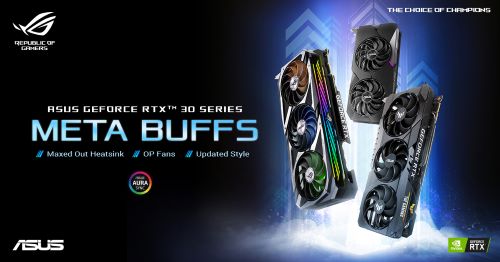
Asus, right after the NVIDIA launch of the RTX 30 Series, has also announced their ROG STRIX, TUF Gaming and Dual NVIDIA GeForce RTX 30 Series lineup. During the Meta Buffs Event, the ROG STRIX was teased; and in this article we’re covering all of ASUS’ lines.
Table of Contents
NVIDIA RTX 30 Series Summary
The NVIDIA RTX 30 series feature new RT cores, Tensor Cores and streaming multiprocessors. The new components improve frame rates; while, giving impressive visuals when gaming. AI is pretty much on board, accelerating games and creative applications. It is powered by NVIDIA Ampere architecture, delivering increases of up to 1.9x performance-per-watt over the previous generation. This effortlessly powers applications and games at all resolutions; even up to 8K with the top end model (RTX 3090). The new RTX 30 Series represent the greatest generational leap in the history of NVIDIA.
ROG STRIX NVIDIA GeForce RTX 30 Series
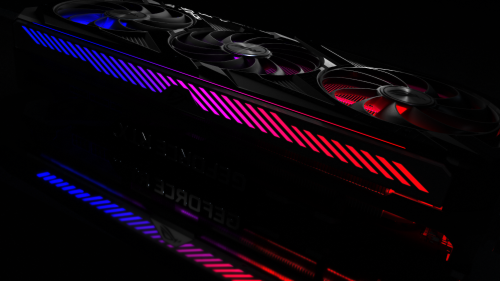
The ROG Strix NVIDIA GeForce RTX 30 Series receives a host of improvements. This range from changes in the heat sink design, to fan design, and up to built-in features of the GPU.
The GPU sports a new design shroud with metallic accents that wraps around a trio of Axial-tech fans. The two flanking fans have 11 blades and have a half-height barrier rings that disperse air laterally pushing air through the cooling array. The middle fan has a reversed rotational direction that reduces turbulence between fans, and emphasis on higher static pressure.
Thermal Redesign
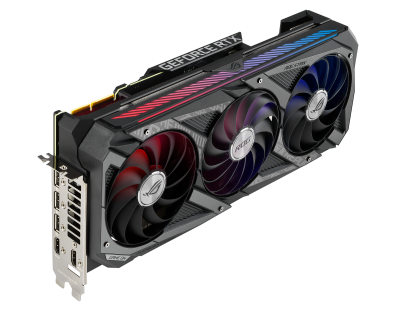
A large heatsink that fills the GPU’s 2.9 slot footprint has a design that leverages the increased airflow. MaxContact Technology ensures heat moves quickly away from the die and transfers to the heat sink array. This technology has the surface of the heat spreader have a mirror like polish at the microscopic level. This ensures the best contact for enhanced thermal transfer.
Aside from improved cooling design, the GPU comes with top shelf capacitors, chokes and power-stages deliver power effortlessly . ASUS calls the components as Super Alloy Power II. ASUS uses its exclusive Auto-Extreme automated manufacturing process to solder the components onto the PCB This ensures smooth connections and meets ASUS’s rigorous specifications.
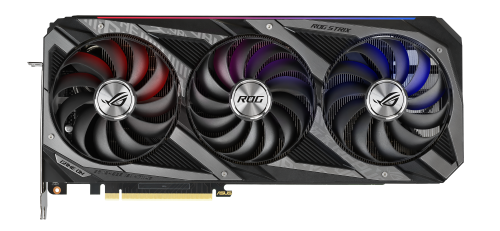
FanConnect II headers allow tuning of the fans based on CPU and GPU temperatures, dynamically providing extra intake or exhaust for demanding tasks at a moments notice. Dual BIOS is a feature that comes in the GPU. This allows users to switch between performance or quiet profiles without software. An onboard voltage sensing circuit that monitors PSU rail voltage. The sensors light up the connector/s when a drop in rail voltage occurs. And this helps users during debugging after crashes occur.
Improving Durability
The front side of the GPU has been buffed up. Addressable RGB element can be customized with Armoury Crate software and the metal frame of the STRIX GPU provides an actual layer of rigidity for the card.
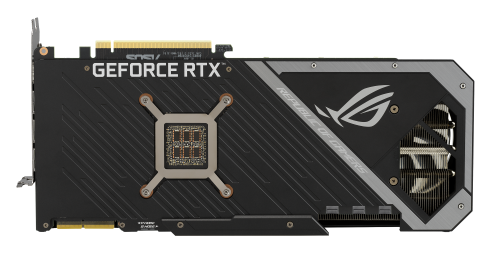
The backplate has a wide vent that allows hot air to escape. This takes a cue from the NVIDIA Reference Design. Beneath the GPU, a bracket provides consistent mounting pressure between die and heat spreader. The I/O bracket is made out of Stainless Steel to provide a more secure mount.
The features listed sums up the improvements made for the ROG STRIX series.
TUF Gaming NVIDIA GeForce RTX 30 Series

Like its top-of-the-line STRIX brethren, improvements are implemented in the new TUF Gaming GPUs. New all-metal shroud houses three powerful axial-tech fans that utilize durable dual ball bearings. To reduce turbulence, fan rotation is optimized and a stop mode stops the fans at low temperatures. Independent heatsinks for the GPU and Memory keep thermals under tight control.
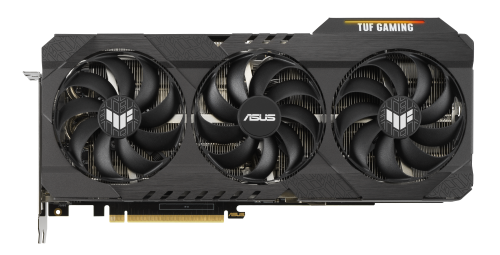
As always, TUF Gaming use military grade components; from top-shelf chokes and MOSFETs, to capacitors. ASUS’s Auto-Extreme automated manufacturing process ensures components are placed and attached accurately. ASUS performs a 144 hour validation trial to ensure flawless performance.

Similar to the reference NVIDIA design, the backplate comes with a vent to let heat escape upwards to the chassis exhaust. Like the STRIX, a bracket allows for consistent mounting pressure to the die and heat spreader. The rear I/O bracket uses Stainless Steel to provide a secure mount. And the TUF Gaming RTX 30 Series GPU comes with Dual BIOS switch to customize profiles without the need of software support.
ASUS Dual NVIDIA GeForce RTX 30 Series
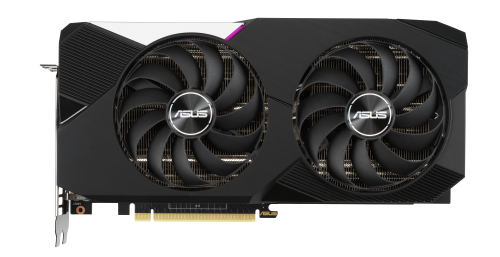
The ASUS Dual GeForce RTX 3070 focuses on performance and simplicity. It leverages advanced cooling technologies from the ROG and TUF graphics cards.
A clean shroud matches the aesthetics found on workstations and even decked-out desktop builds alike. Two tried and true Axial-tech fans provide ample airflow to the heat sink. Finally, to prolong the fans’ lifespan, a stop mode works when the GPU temperature is low.
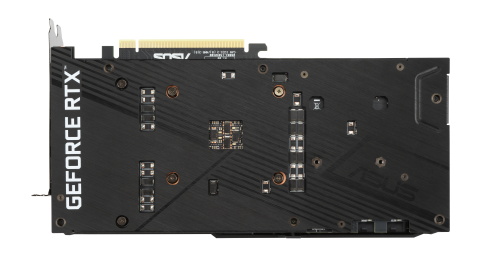
Like the flagship models, the Dual GeForce RTX 3070 utilizes Auto-Extreme Technology for construction. Therefore it reduces thermal strain on components. Aside from better connection and improved overall quality; it results in less environmental impact. An aluminum backplate and stainless steel I/O bracket help protect the PCB from flexing.
Availability and Pricing
ROG Strix, TUF Gaming and Dual NVIDIA GeForce RTX 30 Series GPUs will be available worldwide starting September 2020. For the Philippine pricing and availability, please stay tuned for updates.
SPECIFICATIONS
ROG STRIX GeForce RTX 3090

- NVIDIA GeForce RTX CUDA cores: 5248
- 24 GB GDDR6X memory
- PCIe interface: 4.0
- 2 x Native HDMI 2.1 output
- 3 x Native DisplayPort 1.4a
ASUS TUF Gaming GeForce RTX 3090
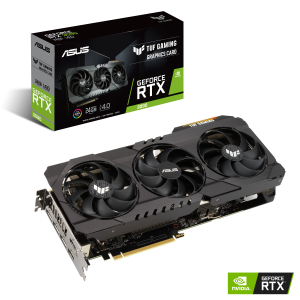
- NVIDIA GeForce RTX CUDA cores: 5248
- 24 GB GDDR6X memory
- PCIe interface: 4.0
- 2 x Native HDMI 2.1 output
- 3 x Native DisplayPort 1.4a
ROG STRIX GeForce RTX 3080
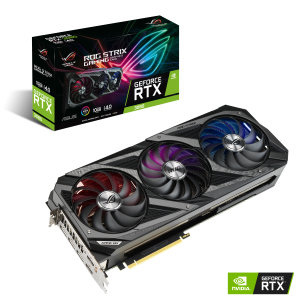
- NVIDIA GeForce RTX CUDA cores: 4352
- 10 GB GDDR6X memory
- PCIe interface: 4.0
- 2x Native HDMI 2.1 output
- 3 x Native DisplayPort 1.4a
ASUS TUF Gaming GeForce RTX 3080
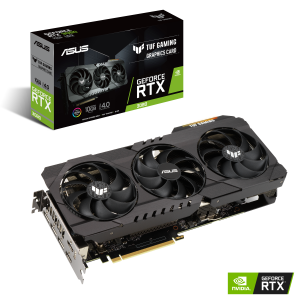
- NVIDIA GeForce RTX CUDA cores: 4352
- 10 GB GDDR6X memory
- PCIe interface: 4.0
- 2x Native HDMI 2.1 output
- 3 x Native DisplayPort 1.4a
ROG STRIX GeForce RTX 3070
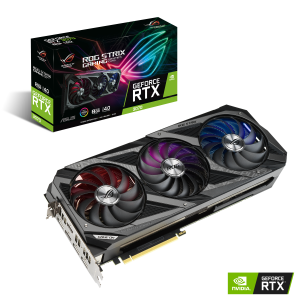
- NVIDIA GeForce RTX CUDA cores: TBD
- 8 GB GDDR6 memory
- PCIe interface: 4.0
- 2 x Native HDMI 2.1 output
- 3 x Native DisplayPort 1.4a
ASUS DUAL GeForce RTX 3070

- NVIDIA GeForce RTX CUDA cores: TBD
- 8 GB GDDR6 memory
- PCIe interface: 4.0
- 2 x Native HDMI 2.1b output
- 3 x Native DisplayPort 1.4a





